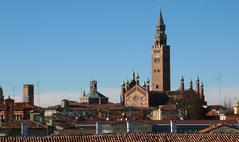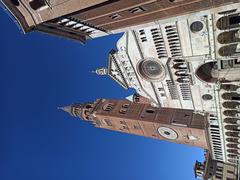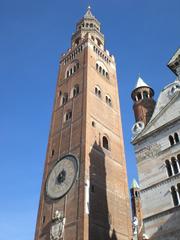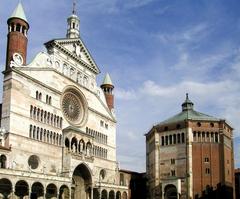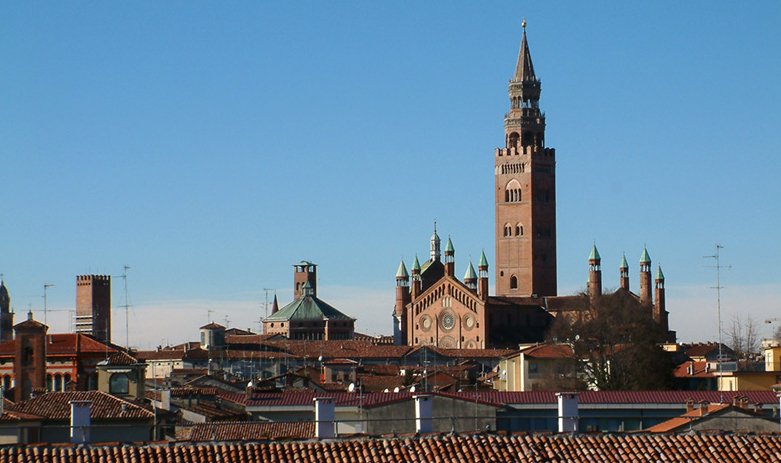
Torrazzo of Cremona: Complete Guide to Visiting Hours, Tickets, and Historic Highlights
Date: 15/06/2025
Introduction
The Torrazzo of Cremona is Italy’s tallest brick bell tower and a symbol of the city’s medieval ambition, Renaissance ingenuity, and enduring cultural heritage. Towering at 112.54 meters (369 feet), it dominates the historic Piazza del Comune and stands beside the Cathedral of Santa Maria Assunta. The Torrazzo’s distinctive blend of Romanesque and Gothic architecture, its monumental astronomical clock, and its melodious bells make it one of the most important historical sites in Lombardy and a must-see for visitors to Cremona (Cattedrale di Cremona; Stickymangorice; finestresullarte.info).
This comprehensive guide covers everything you need to know about the Torrazzo of Cremona: its historical evolution, architectural innovations, astronomical clock, bell chamber, the Vertical Museum, practical visitor information—including visiting hours and ticketing—and tips for making the most of your experience.
Historical and Architectural Overview
Construction and Evolution
Construction of the Torrazzo began in the early 13th century with a solid Romanesque base, completed around 1230. The tower was gradually extended, culminating in its octagonal lantern and spire by 1309, reflecting the Gothic style that became prominent in Lombardy. At 112.54 meters, the Torrazzo remains the tallest brick bell tower in Italy and the third tallest worldwide, preceding other famous towers with its height and architectural prowess (Cattedrale di Cremona; Wikipedia; Italian Traditions).
Architectural Features
The Torrazzo’s red brick façade, square base, decorative arches, and conical spire exemplify the transition from Romanesque to Gothic styles. The structure’s design reflects not only religious devotion but also the civic pride and competitive spirit of medieval Italian cities, where monumental towers symbolized urban prestige (finestresullarte.info).
The Astronomical Clock: Art, Science, and Symbolism
Origins and Design
Installed between 1583 and 1588 by Francesco and Giovan Battista Divizioli, the astronomical clock is the largest in the world, measuring 8.2 meters in diameter. Its face, positioned low on the tower for visibility, is adorned with vibrant zodiac symbols, depictions of the sky, and multiple rings marking hours and months. Four hands track the positions of the sun, moon, and zodiac, as well as lunar phases and eclipses (StickyMangoRice).
Function and Legacy
The clock was not only a technical marvel but also a public astronomical calendar, reflecting Renaissance fascination with time, astronomy, and the universe. It continues to function today, wound by hand and admired for its blend of artistry and scientific precision (StickyMangoRice).
The Bells: Sound and Tradition
Historical Overview
The bell chamber contains seven bells, each dedicated to a different saint, along with the “Bell of the Hours” dating from 1581. The current set was recast in 1744, retaining the original clappers. The bells are tuned in A-flat major and play a significant role in marking religious ceremonies, civic events, and the rhythms of daily life in Cremona (Cattedrale di Cremona; in-Lombardia).
Access and Experience
Visitors climbing the 502 steps can closely observe the bells and enjoy panoramic views from the summit. The bell chamber is a highlight for those passionate about music, history, or engineering.
The Vertical Museum: A Journey through Time
Overview
Since 2018, the Torrazzo hosts the Vertical Museum, a multi-level exhibition dedicated to timekeeping, astronomy, and the tower’s history. The museum’s themed halls include:
- Hall of Astronomy: Explores the relationship between celestial studies and timekeeping.
- Hall of the Dial: Displays the original astronomical clock dials and related instruments.
- Hall of the Mechanism: Showcases the Renaissance clock mechanism and calibration devices.
- Hall of the Measurement of Time: Traces the evolution of horology through multimedia exhibits (museoverticale.it; turismocremona.it; finestresullarte.info).
Foucault’s Pendulum
A highlight of the museum, the Foucault’s Pendulum, visually demonstrates Earth’s rotation, reinforcing the Torrazzo’s role in scientific education (turismocremona.it).
Visiting Information: Hours, Tickets, Accessibility
Visiting Hours
- Standard Opening: Tuesday to Sunday, 10:00–13:00 and 14:30–18:00. Last climb 30 minutes before closing. Closed Mondays (especially in January and February) and select holidays (turismocremona.it).
- Seasonal Variations: Check the official museum website for holiday schedules and special events.
Ticket Information
- Combined Ticket: Includes the Torrazzo, Baptistery, and Diocesan Museum—€10.00 (as of June 2025).
- Torrazzo-Only Ticket: Available on Mondays for €5.00.
- Vertical Museum Admission: Approximately €7 for adults, with reduced fares for children, students, and groups.
- Purchase: Tickets available online (Musei Diocesani ticket office), by email ([email protected]), or at the site.
Accessibility
- Climb: The ascent to the bell chamber involves 502 steps with no elevator, making it unsuitable for those with limited mobility.
- Museum: Lower museum areas are wheelchair accessible.
- Visitor Tips: Wear comfortable shoes, bring water, and check weather conditions.
Guided Tours and Events
- Guided tours, available in multiple languages, deepen understanding of the Torrazzo’s history, architecture, and astronomical features.
- Special events and cultural activities, including bell-ringing demonstrations and exhibitions, occur throughout the year (turismocremona.it).
Nearby Attractions
- Cremona Cathedral (Santa Maria Assunta): Noted for its frescoes and Romanesque-Gothic design.
- Baptistery of St. John the Baptist: Octagonal Romanesque building adjacent to the Torrazzo.
- Museo del Violino: Celebrates Cremona’s global reputation for violin-making.
- Piazza del Comune: The heart of Cremona’s civic life, surrounded by historic buildings (finestresullarte.info).
Cultural Significance and Local Traditions
Symbolism and Legend
The Torrazzo is more than an architectural feat; it is the city’s emblem, representing faith, resilience, and innovation. Local legend tells of a lion whose bones are believed to be buried beneath the tower, a symbol of courage and rebirth celebrated in festivals (Italoamericano).
Music and Festivals
Cremona is famous for its luthier tradition, with figures like Stradivari and Amati. The Torrazzo’s bells echo this musical heritage, and the annual Cremona Musica festival often hosts events in its shadow (in-Lombardia; Tourspilot).
Culinary Legacy
The famous torrone nougat was first made in 1441 for a royal wedding, shaped to resemble the Torrazzo—an example of how the tower has inspired local traditions (StickyMangoRice).
Practical Visitor Tips
- Best Times: Visit early morning or late afternoon for fewer crowds and optimal lighting.
- Photography: Allowed throughout the site; panoramic views ideal for photos.
- Visitor Services: Info point, restrooms, and gift shop available at the tower base.
- Travel: The Torrazzo is a 15-minute walk from the Cremona train station; parking facilities and public transport are convenient.
Frequently Asked Questions (FAQ)
What are the Torrazzo’s visiting hours?
Tuesday to Sunday, 10:00–13:00 and 14:30–18:00; closed Mondays. Holiday hours may vary.
How much do tickets cost?
Combined tickets: €10.00; Torrazzo-only tickets: €5.00 on Mondays; Vertical Museum admission: ~€7. Discounts available.
Is the climb accessible?
The 502-step climb is not suitable for people with mobility issues. The museum’s ground floor is accessible.
Are guided tours available?
Yes, in multiple languages; book in advance or on-site.
What else can I see nearby?
The Cathedral, Baptistery, Museo del Violino, and historic piazzas are all within walking distance.
Visuals and Media Resources
- Images: Exterior of the Torrazzo, astronomical clock face, bell chamber, panoramic city views.
- Virtual Tours: Explore online galleries and interactive maps via the Vertical Museum website.
- Keywords for Accessibility: Use alt text such as “Torrazzo of Cremona visiting hours” and “Cremona historical sites” for all images.
Conclusion and Call to Action
The Torrazzo of Cremona offers visitors a rare blend of history, architectural beauty, scientific marvel, and cultural vibrancy. Whether you are climbing its historic steps, exploring the Vertical Museum, or immersing yourself in local legends, the experience is unforgettable. For up-to-date visiting hours, ticket purchases, and event information, consult the Musei Diocesani di Cremona and Cattedrale di Cremona official websites.
Enhance your journey with the Audiala app—your gateway to expert guides, travel tips, and curated content about Cremona’s historical sites. Plan ahead, book your tickets, and make your visit to the Torrazzo a highlight of your Lombardy adventure.
References
- Cattedrale di Cremona
- StickyMangoRice
- Musei Diocesani di Cremona
- in-Lombardia
- finestresullarte.info
- turismocremona.it
- Italian Traditions
- Wikipedia
- Italoamericano
